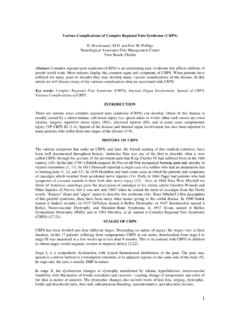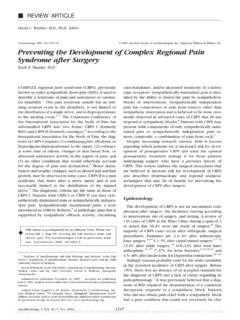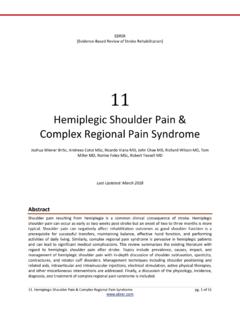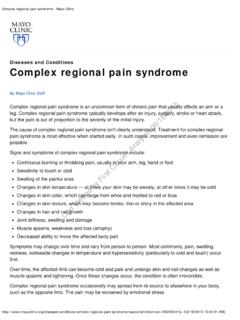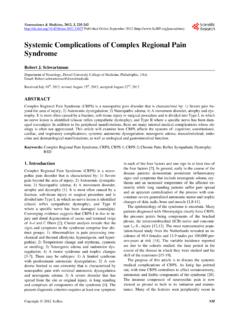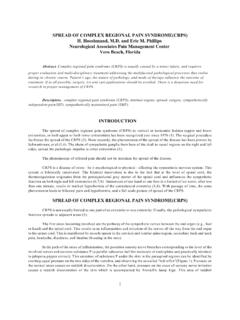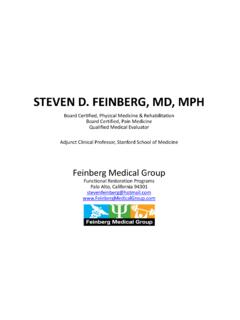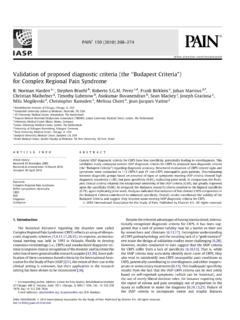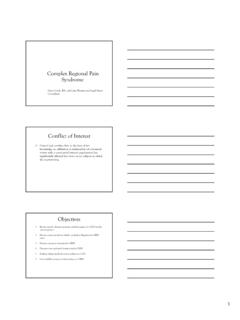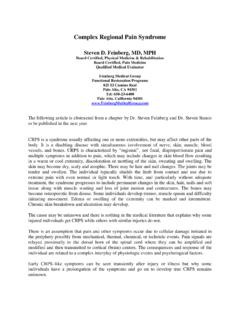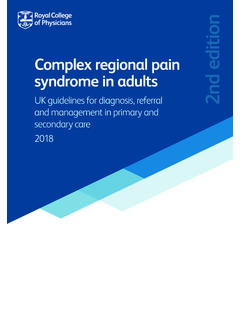Transcription of So your student has CRPS…Now what? - rsdinfo.com
1 Welcome and thank you! This resource has been designed for you, as a school administrator, teacher, nurse or staff support person to better understand CRPS, and how you as a school can support your student with CRPS. This resource has been provided to you as one of your students has been diagnosed with complex regional pain syndrome (CRPS), also known as Reflex Sympathetic Dystrophy syndrome (RSD). This resource will help to answer some of the early questions you may have about CRPS and will hopefully help foster ongoing discussions between the school, student and their guardian(s). Working together, to find proper accommodations and supports will help to ensure that this student can thrive in spite of this complex , and devastating condition. CRPS is a debilitating, painful condition that will pose an incredible challenge to your student .
2 It will also require a lot of effort by the student , his/her guardian(s) and the school, to find the appropriate accommodations to 1 Welcome + Thank youWhat is CRPS?Experiences of people living with CRPSWhat does this mean for my student living with CRPS?What factors will impact the student s ability to learn?What can you expect of, and from, your student ?How to support a student living with CRPS735191011 Accommodations + modifications for student successAdditional ResourcesContact information131616A resource for school administrators , nurses and teachers to understand complex regional pain syndrome (CRPS), also known as Reflex Sympathetic Dystrophy syndrome (RSD), and how to support a student with this conditionSo your student has what?
3 ContentsINTERNATIONAL RSD FOUNDATION support success! This may be an overwhelming challenge for you, as a school administrator, teacher, school nurse or support staff. However, your support, and understanding are what will make a difference in your student s life! So, thank you! It cannot be stressed enough that the schools approach towards this student be one of an interdisciplinary team including administrators, teachers, school nurse and any other support staff. This will also require open communication with the student , and their parent(s)/guardian(s). Nurses are an essential part of the team, as at times the student may spend more time in the nurses room, than in class. The school nurse can also properly administer any medications the student requires.
4 This will require open communication with the student s guardians to ensure they know any added or removed medications. As educators, you know the value of education and ensuring supportive school environments. You know these lay the foundation to provide students with a bright start, and promote wellbeing later in life. The human brain undergoes rapid development in the early years, and continues to develop into ones late 20s. Throughout their educational years, children and youth, are building cognitive skills, gaining knowledge, and acquiring essential building blocks for the future, such as social-emotional and problem solving skills. Ensuring that your student living with CRPS thrives, in spite of this condition, is paramount. Thank you for taking the time to better understand this condition, the impact it has on your student , and methods the school and staff can best use to support the student s academic and social success.
5 your support will help the child feel a sense of normalcy in life by attending school, being a part of regular school activities with his /her peers. 2 INTERNATIONAL RSD FOUNDATION What is CRPS? CRPS is a poorly understood, and understudied, progressive neurological pain syndrome . It can affect anyone, at any age. CRPS is primarily a neuropathic, and partially musculoskeletal pain disorder, which also affects the autonomic system. It is a chronic disorder, which, if left untreated, can lead to disability and functional limitations. Despite there not being one definitively known cause, there are two types of CRPS: CRPS I reflects the absence of a nerve injury (initially referred to as RSD); and, CRPS II reflects the presence of a nerve injury. Developing this condition can be attributed to a traumatic event such as surgery, a fall, sprain, or fracture, and even in some cases, just bumping ones toe.
6 The pain is out of proportion to what would normally be expected of the injury. It most often affects an extremity (arm or leg), but can also move internally. You can imagine how confusing this would be to both the patient and their family! The McGill pain scale, developed to rate various pain related traumas, found CRPS pain to be more intense than childbirth, an amputation of a finger or toe, and chronic back pain for example. CRPS affects anyone at any age. However, among school aged children and youth, CRPS is more common among pre-adolescent and adolescent girls than boys. While there is no single reliable diagnostic test, a clinical diagnosis is made based on examination meeting clinical diagnostic criteria based on their signs and symptoms, and patient history. While pain , out of proportion to the original injury, is one of the first signs of this condition, there are ranges of other symptoms that must be met.
7 Symptoms of this condition range depending on the person living with CRPS, and therefore not every person with CRPS will have all of these symptoms and symptoms will vary. Symptoms can also change over time as a result of treatment(s), medication(s), and stress, for example. 3 Support and empathy are essential! CRPS can lead to severe depression. Given this condition, and its implications on one s life, it is imperative that your student be supported, and receive empathy and understanding from those around them. INTERNATIONAL RSD FOUNDATION your student is likely experiencing a number of the symptoms listed below. If you want to know more about your student s experience, and their symptoms to ensure proper precautions are taken, the family is likely open to sharing more information.
8 Symptoms of this condition include: 4 stages of CRPS: CRPS has four stages. Depending on the originating injury, the duration of each stage can vary. In comparison to adults, the stages of CRPS in children often stagnate, reverse, or improve slowly. CRPS has confusing clinical manifestations of this condition, especially since not all signs and symptoms may be present neither at the same time nor in each patient. Stage I: pain may spread in a mirror fashion to different areas of the body (ie hand to foot, foot to hand, or right side to left side). Stage II: There can be a noticeable change to both skin temperature and color; even in a matter of minutes, and can change all the time. The patient may also have hair loss, brittle and discoloured nails, and/or a skin rash, for example.
9 Stage III: Atrophy to different degrees is seen. However, this may be less noticeable due to inflammation and swelling. In both stage II and III is not at all uncommon for CRPS to spread to other extremities. At times, it may become generalized. Stage IV: Is the final stage of CRPS, and points towards the exhaustion of both the autonomic and immune systems. This includes a number of chronic, and medically concerning issues including for example: Immune system failure, intractable hypertension and edema, and a heightened risk for cancer. 4 Burning sensation (as though someone has lit their affected limb or part of their body on fire) Hyperalgesia (heightened sensitivity to pain . pain is higher than expected for the initial injury) Allodynia (experiencing heightened pain from non-painful stimulation of the area affected such as a light human touch, touch of clothing, bedding, or water) Autonomic dysfunction, such as sweating, skin color changes, and changes in skin temperature (affected limb can be substantially colder than the other).
10 Trophic changes. This may include reduced or no hair growth on affected area, skin changes, and brittle/cracked nails. Altered motor function such as weakness, reduced range of motion, muscle atrophy. Inflammation Spasms Insomnia and emotional disturbances- Significant changes to the limbic system, which is responsible for sleep, short-term memory problems, difficulty concentrating, word recall, confusion, etc. INTERNATIONAL RSD FOUNDATION Experiences of people living with RSD: While there is no cure, CRPS remission is possible. The prognosis for children with CRPS is much better than for adults. While remission is possible, it is important to note that the focus and goals for CRPS treatment and management is on rehabilitation, not on completely reducing pain .
